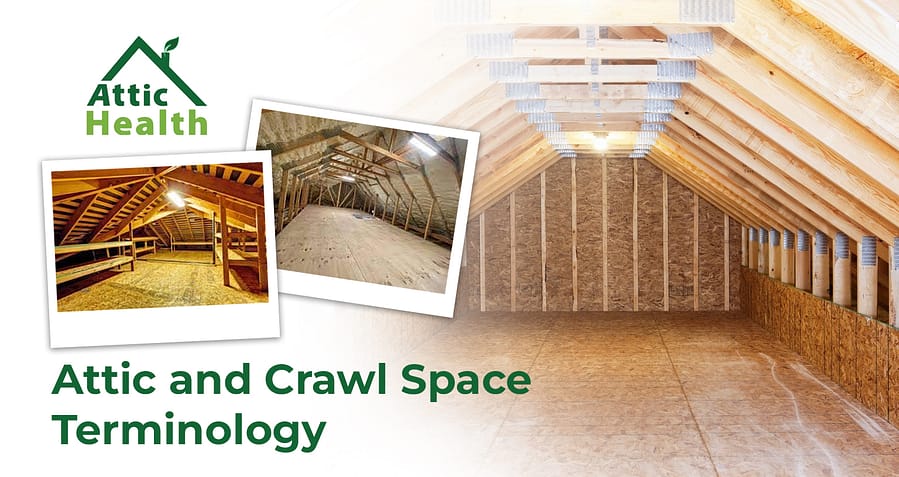What is an attic in a house?
The attic serves as the intermediary space located between the roof and the ceiling of the uppermost interior floor of a home. Often utilized for insulation purposes, they also house essential heating and air conditioning (HVAC) equipment. This concealed area not only regulates temperature but also contributes to the energy efficiency and overall comfort of the entire household.

Why is it called an Attic?
The term originally comes from the Greeks as the region of Attica, where all their homes had facades above the main floor of the home. Attics were used to raise the height of a building to make it look more prominent, and for decorative purposes as the top most point of a building was particularly important to ancient Greeks architects.
Specific Attic Components
- Attic Entry Door: Often attics will have a ceiling pull down door, but if the space has enough space to stand, often there can be a normal door from a loft space to the attic where insulation and roof truss structural beams can be seen, or perhaps they are covered in drywall and packed with insulation.
- Attic Fans: Some homes have a need for fans to keep the attic space from overly heating to where it can produce moisture build up or other issues.
- Insulation Material is quite common in attics and crawl spaces. There are many different types of insulation, read more on our Insulation page!
- HVAC System including ventilation ducts, metal ductwork, the furnace, Air Handler, gas lines, electrical lines and water drainage pipes.
- Recessed lighting components and wiring
- The roof truss or the wooden framework that creates an attic has many cross beams, but the floor of an attic is made up of the home’s internal ceiling joists and the ceiling of an attic space is the rafters.
- Often there are pipes, gas lines and electrical conduits passing through the attic to keep them out of sight from below or because it is often the most efficient way to route things through the home via the attic or crawl space.
Attic and the Home Envelope
The attic is only the cap on an innovative concept of the home envelope, a final barrier between the exterior and the home’s inside edge. The home envelope includes the crawlspace, the home and the attic as a complete structure with a goal to keep out and keep a safe interior. Often the home envelope will be mentioned when discussing temperature control, HVAC systems, and the air sealing of your home.
Think of the crawlspace as the more open end of the envelope as the attic is the cap of the home envelope. Depending on the crawl space, it could be an open end to the envelope, or more of a seal, look under the crawl space for general information to understand more.
Crawl Space General Information
What is the Crawl Space?
A crawl space refers to the space between the ground and the underlying surface of the flooring of a home or business. This space is usually empty except for home essentials such as plumbing pipes, electrical wire conduits, on the flooring there is often a vapor barrier, and the ceiling of the crawl space may have insulation.
The space has been given the name crawl space because it is often only 1 foot to 3 feet of clearance, and has a door that also needs to be crawled through to enter the crawl space.
What is the Purpose of a Crawl Space under a House?
Crawl spaces are the first line of defence to keeping pests out of a home, keeping moisture out, and generally keeping the outside out. Crawl spaces work to protect the home from the moisture of the soil, which can be one of the hardest battles for the crawl space as ventilation and moisture barriers don’t always perform at the level needed to keep the space dry.
Sometimes flooding from rain can access the crawl space and cause trouble, but the crawl space is designed to keep the home prepared for all weather conditions, especially when wet.
What is the Difference Between a Crawl Space and a Foundation?
The foundation is the cement slab that connects the earth and anchors the wooden structure of a home together. Often a raised foundation will create a space between the foundation walls that create a crawl space under the home. Sometimes, a building foundation will not include a crawl space.
A crawlspace is a good tool for a home’s relationship to the earth, the weather and other outside forces. The crawlspace is essential for homes that have a colder climate or a lot of fluctuation in the weather throughout the year. The crawl space helps protect the home from external factors, such as the frost line.
The crawl space works best in warmer environments, if you live in a very cold climate, you may need to have a basement to protect against the frost line.
Is Crawl Space Good or Bad?
A crawl space is a neutral solution for homes to maintain their temperature, comfort, and dryness, and also keep pests out. The performance of your home’s crawl space is often determined by the weather, and ventilation vents being opened or closed, but often pests can cause the crawl space to create problems. A crawl space can be a good or bad place depending on the homeowner’s maintenance or the space and the property in general.
A crawl space visit is often something most service technicians will want to avoid, because often it is not kept up well, but more than that, many homeowners have used the crawl space for storage of junk that they have removed from the yard or the driveway.
It is not uncommon to find car parts, tires, pool equipment, old lawn furniture, broken pipes, old pest traps, or other junk in a crawl space. Often this mess of junk, hazardous materials, and pest-related equipment has given the crawl space a bad connotation.
What are the disadvantages of a crawl space?
When your home is in an environment where the frost point is low, this causes more frost to accumulate on the exterior parts of the home. This is not necessarily a bad problem, but the moisture that escapes into the pockets of your home, such as the ceiling of the crawl space, is the problem.
This moisture can build up, and lead to mold and the mold will eat away at your home’s structure while attracting pests and more problems. While a crawl space can have disadvantages, getting an expert to help you balance the proper ventilation strategy, installing vapor barrier, and making sure crawl space insulation is properly done with a moisture barrier can justify the use of a crawl space versus a concrete slab foundation or basement.
Attic Health Wrap-Up
The home is where the heart is so having all the tools and features to protect the home is important. The attic and the crawl space are often forgotten but the poorly maintained attic or crawl space is unforgettable. You can either use the crawl space as storage or use it as a functional barrier between your home and external threats.
Also, the attic has about the same sentiment, but because the attic space is away from the dirt and grim, you might be able to use it as storage and also serve its purpose of insulating the home and properly capping the home envelope. Attic Health is here to serve you with any attic-related services from attic insulation to the final professional cleanup after attic insulation removal.


